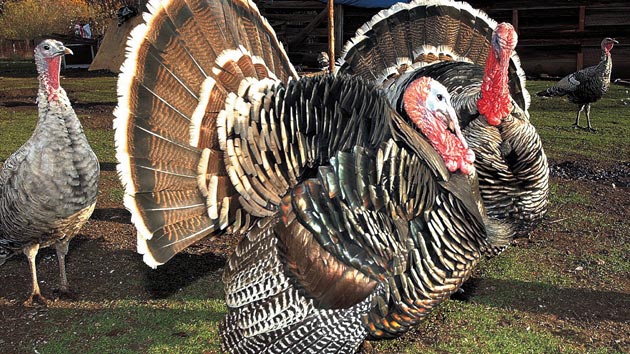
Andrew Mariman/AP
The first time I heard about the Slow Food movement, recently arrived on our shores from its native Italy, I thought the whole idea sounded cute. Here were a bunch of well-heeled foodies getting together to celebrate the fast-disappearing virtues of the slow life: traditional foods traditionally prepared and eaten at leisurely communal meals. They aimed to save endangered domestic plants and animals—the Vesuvian apricot, the Piedmontese cow—by eating them. Slow Foodies were antiquarian connoisseurs, I figured, with about as much to contribute to the debate over the food system as a colloquium of buggy whip fanciers might have to add to the debate over SUVs.
Certainly it’s hard to take seriously a political movement that has a snail for a mascot and a manifesto calling for “a firm defense of quiet material pleasure.” But after learning more about it recently, I’ve come to think that Slow Food might actually have a serious contribution to make to the debate over environmentalism and globalism. Not that any self-respecting member of Slow Food would ever want you to think they take themselves that seriously; pleasure is at the very heart of their movement, which is dedicated to the proposition that the best way to defend the planet’s cultural and biological diversity is to enjoy it at the table, slowly. Whether it means to or not, Slow Food is mounting a provocative challenge to some stale lefty assumptions about consumption, free trade, and the place (if any) of pleasure in our politics.
As its name suggests, Slow Food is a reactionary organization, but reactionary in the best sense. It took shape 17 years ago in the brain of Carlo Petrini, a left-wing Italian journalist dismayed by the opening of a McDonald’s on the Piazza di Spagna in Rome—and perhaps equally dismayed by the hangdog dourness of his comrades on the left. After years of activism he had come to the conclusion that “those who suffer for others do more damage to humanity than those who enjoy themselves,” as he recently told a group of journalists. “Pleasure is a way of being at one with yourself and others.” So rather than picket McDonald’s’ new outpost in the heart of Rome, or drive a tractor through it à la José Bové, Petrini organized a group of like-minded activist-cum-sybarites to simply celebrate all those qualities that McDonald’s’ inexorable drive toward the homogenization of world taste threatens: the staunchly local, the irreplaceably unique, the leisurely and communal. His (so-very-Italian) idea was to launch a political movement conceived under the signs of pleasure and irony: Dionysus meets Dario Fo.
Seventeen years later, McDonald’s is still serving Happy Meals by the Spanish Steps (though Petrini did persuade the company to hold the golden arches), yet Slow Food has emerged as a thriving international organization, with more than 65,000 members in 45 countries, a successful publishing operation (Slow Food’s Gambero Rosso—an indispensable Zagat-like guide to Italian food and wine—pays most of the bills), and the Salone del Gusto, a biannual trade show that brought 126,000 eaters together with artisanal food producers in Turin last October. Just as important, Slow Food has launched a handful of decidedly eccentric institutions and ideas—the Ark of Taste, the presidia, “eco-gastronomy,” and “virtuous globalization.” Unpack these terms and you have a pretty good idea what’s afoot—and at stake.
The Ark of Taste is basically the list of endangered food plants and animals that Slow Food has resolved to defend against the rising global tide of McDonald’s-ization. Some American passengers recently added to the Ark include Iroquois white corn, the red abalone, the Narragansett turkey, the Sun Crest peach, and the Delaware Bay oyster. We’ve come to think of biodiversity as a biological crisis of wild species, but the survival of the domesticated species we’ve depended on for centuries is no less important. For one thing, when the latest patented hybrid-corn variety meets its bacterial or fungal match, as all monocultures sooner or later do, breeders will need these heirloom varieties to refresh the gene pool. Should that Iroquois white corn fall out of production, as it very nearly did a decade ago, an irreplaceable and quite possibly crucial set of corn genes would be lost to the world.
Of course seed-saver groups have been around for a while now, preserving heirloom varieties from the onslaught of patented hybrids, but Slow Food takes that project a step further. The movement understands that every set of genes on its Ark of Taste encodes not only a set of biological traits but a set of cultural practices as well, and in some cases even a way of life. Take the example of Iroquois white corn. By working to find new markets for this ancient cultivar, Slow Food (along with the Collective Heritage Institute, its partner in this particular project) is ensuring the livelihood of the Native Americans who grow, roast, and grind this corn (on the Cattaraugus reservation in western New York) and the specific culinary and spiritual uses that corn has been selected over hundreds of years to support. “Save the Corsican Chèvre!” might not sound like a life-and-death battle cry, until you realize, as Slow Food teaches, that as those goats go, so goes something greater: a specific, irreplaceable mode that a particular people have devised for living on, and off, a particular corner of the earth. Save the genes, and you help save the land and the culture as well.
Slow Food recognizes that the best place to preserve biological and cultural diversity is not in museums or zoos but, as it were, on our plates: by finding new markets for precious-but-obscure foodstuffs. This is what is meant by “eco-gastronomy.” Slow Food features the foods and their producers at its Salone del Gusto (Hall of Taste), and organizes tastings at its local chapters (called Convivia), where an effort is made to educate palates in the course of exercising them at a feast. This emphasis on celebration and connoisseurship has left Slow Food open to charges of elitism, but the organization has worked hard to reach beyond the affluent foodie crowd. Slow Food USA has launched a garden project for public schools, and a great many of the foods it has championed in the United States are distinctly populist and often cheap: Barbecue and beer are as much a part of the movement as endangered oysters and rare sakes. “To me, Slow Food is spending a few quarters on a Spitzenberg apple instead of a Red Delicious,” says Patrick Martins, the energetic young director of Slow Food USA. “It doesn’t have to be an everyday thing.” Sure, fast food is always going to be “cheaper” than slow food, but only because the real costs of the industrial food chain—to the health of the environment, the consumer, and the worker—never get counted.
Even Slow Food’s concern with connoisseurship is not as effete as it might sound. Along with the industrialization of our food system has come an industrialization of eating, and the former won’t be effectively countered until people have rejected the latter. Slow Food aims to teach us to taste what makes Iroquois corn special (it’s wonderful stuff, with an earthy, sweet, extra-corny flavor that makes commercial corn products taste pallid by comparison) and to slow down to enjoy some slow dishes traditionally cooked with it. (Like posole, a smoky Southwestern stew of dried roasted corn that, made right, can take all day.)
Paradoxically, sometimes the best way to rescue the most idiosyncratic local products and practices is to find a global market for them. This is what Slow Food means by “virtuous globalization,” a simple but powerful idea that throws a wrench of complexity into the usual black-or-white arguments over free trade. It is no accident that food has emerged as a flash point in the free-trade debate; what we eat is a marker of our cultural identity, which is why threats to that identity, whether in the form of a new fast-food outlet or a genetically engineered crop, can excite such vehement reactions, as companies like McDonald’s and Monsanto have discovered.
Certainly, the main tendency of globalism has been in the direction of the McDonald’s ideal of “one world, one taste,” but Slow Food makes a good case that globalism’s power can also be exploited to save the local cultures most threatened by it. So a Piedmontese grower of a rare, wonderfully tasty but comparatively unproductive strain of wheat who can’t find a local market can be, through Slow Food, hooked up with a company like Williams-Sonoma, which knows exactly where to find the affluent home bakers willing to pay a premium for a flour that makes such distinctive bread. One menu item at a time, Slow Food is demonstrating how global trade and mass communication can be turned into powerful tools for rescuing cultural and biological diversity—from precisely those perils of global trade and mass communication. Think of it as a form of economic jujitsu.
Carlo Petrini himself, a round, stubble-bearded Piedmontese in his 50s who looks like he knows how to enjoy himself at a table, has a genius for publicity that has been essential to the success of this strategy. He understands that the glamour that attaches to lavishly advertised global brands like McDonald’s can be effectively countered only by creating a rival form of glamour. But how do you glamorize Iroquois corn flour or the rather scrawny Narragansett turkey? By recruiting great chefs to cook with these foods and extol their virtues. We live in an age when chefs wield unprecedented influence, and Slow Food has been quick to enlist them under its banner. Soon after Patrick Martins opened Slow Food’s U.S. outpost in 2000, he invited Alice Waters, founder of Berkeley’s Chez Panisse, to join the movement, and it wasn’t long before much of America’s culinary establishment had signed on too. Today, Slow Food USA has 10,000 members and 79 regional Convivia.
When merely promoting an endangered food isn’t enough to save it from imminent extinction, Slow Food turns to its network of chefs and civilian members to organize a presidium. “Presidium” is Latin for “armed garrison,” and this is as close to direct action as the movement gets. Take the case of America’s endangered “heritage turkey” breeds. The Bourbon Red, the Narragansett, the Jersey Buff, and the Standard Bronze—the turkeys Americans ate for centuries—have all but succumbed to the aptly named and entirely flavorless Broad Breasted White. This is a turkey that has been so thoroughly industrialized (to produce lots of white meat fast) that it can no longer fly, survive outdoors, or reproduce without help. (Yep, the humongous breasts render conventional turkey sex impossible, so the birds must be artificially inseminated.) Today the U.S. turkey industry is a vast monoculture precariously perched on the beaks of these cosseted birds, which have driven older and more robust varieties to the edge of extinction—by one count only 3,800 breeding birds of these species survived at the millennium.
Early last year Patrick Martins decided to organize a presidium to save the heritage turkey—Slow Food’s term for the four old varieties it targeted. The New York office recruited a network of farmers to raise the birds from eggs it had persuaded hatcheries to produce. The organization guaranteed the farmers $3.50 a pound for its turkeys, advanced them start-up money for feed, and then set about finding restaurants and consumers willing to serve the birds for Thanksgiving. Some 5,000 orders came in, and last November Martins found himself at an Ohio slaughterhouse overseeing the processing of thousands of heritage turkeys, which wound up on the menus of restaurants all over America.
Not to mention on my own Thanksgiving table. I ordered a Narragansett from Pam Marshall, one of the farmers Slow Food had recruited, and paid it a couple of visits over the course of the summer. Last season Marshall grew Broad Breasted Whites and heritage turkeys side by side at her farm in Amenia, New York. She quickly learned why the BBWs (“mindless eating-and-shitting machines,” she calls them) have prevailed in the marketplace: They were oven-ready by August, a full three months ahead of her Bourbon Reds and Narragansetts. The heritage birds took their sweet time getting up to slaughter weight, spending their days exploring Marshall’s pastures, nibbling on clover and bugs, even doing a bit of flying now and then. At Thanksgiving, many of the turkeys were still small and flat of chest.
A handful of turkey buyers, including a few of the chefs, complained to Patrick Martins—they’d been promised 18-pounders, and only a few of the birds could hit that mark. But that’s how it sometimes goes with slow food, Martins explained, shrugging his shoulders. “We don’t call it Slow Food for nothing.” These are, or were, living creatures, not factory-made products, and it is precisely our insistence on predictability and standardization, on quantity rather than quality, that has given us food that looks and tastes…well, as if it came from a factory.
 Illustration: Benoit
Illustration: Benoit
As it happens, I had to dust off Martins’ argument myself when I brought my heritage turkey to the table, a scene that would not have impressed Norman Rockwell. My Narragansett cut a fairly unprepossessing figure on the platter, being rather flat-chested and, um, bereft of both its legs. That’s because Peter Hoffman, a Manhattan chef I’d consulted on cooking my turkey, had counseled me to braise the legs separately. “These birds actually use their legs,” Hoffman explained. “The meat can be chewier than you’re accustomed to.” So I painstakingly removed the legs and braised them in chicken stock for several hours, all the while reminding my impatient self that this too was part of the whole slow-food experience.
The sniggering that initially greeted my slow turkey stopped the instant people had a chance to taste it. The leg and thigh meat in particular was delicious: rich, moist, and tender, with a flavor more reminiscent of duck than turkey. Indeed, simply by virtue of having a flavor, this represented a completely different order of turkey. Now I understood what turkey was like before the triumph of the Broad Breasted White, and why eating turkey had once been considered a great treat—heretofore one of the mysteries of life, as far as I could tell. It never occurred to my guests that by enjoying this Narragansett they were in some small way contributing to its survival, but of course they were: The Slow Food presidium in which I was taking part has already succeeded in nearly doubling the world population of heritage turkeys.
It all seemed too good to be true: that eating something this delicious could be a strategy for preserving biodiversity and that the pleasure we took in doing so could itself constitute a small but meaningful political act. For pleasure itself is all but extinct in American environmentalism (not to mention American eating), and pleasure is part of what Slow Food aims to redeem, by demonstrating that, at least when it comes to the politics of food, the best choice is often the tastiest. Eco-gastronomy isn’t going to save the world, but if it can bring politics and pleasure together on the American plate, the Vesuvian apricot and Delaware Bay oyster won’t be the only species to benefit.














